Wagner: Orchestral Music From the Ring
February 24, 2018
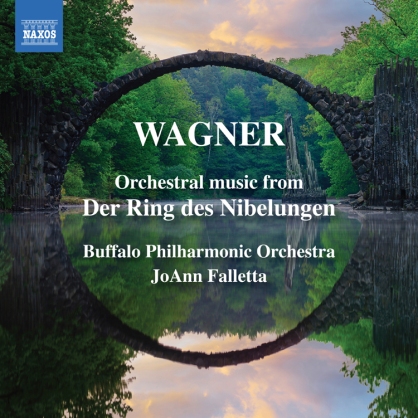

As many of you know in addition to classical music I also have quite a fondness for film music which in my opinion is some of your modern classical music. How can you not listen to “Lord of the Rings” or “Star Trek” and not conjure up thoughts of Rimsky-Korsakov or Wagner. These two composers of the 19th century were the template of material that started 20th century film music. Both of them would have made fine Hollywood composers as they could write the type of music necessary for the wide range of emotions necessary. While there were others these two seem to standout as excellent examples.
The 64 minutes of material is the orchestral material to the 16 hours of opera, something that few people have ever listened to in it’s entirety. It shows the mastery that Wagner had. His ear was tuned to pick up the small nuances that were way over my head such as the use of a bass clarinet and a sax at a critical moment. He wrote as liner note writer Edward Yadzinski described as ‘small tuneful fragments as thematic material for individual characters’ (Leitmotifs). He pioneered the way for Strauss, Mahler, and Stravinsky and influenced Hollywood writers such as Korngold, Horner, and Williams.
All of this talk of theory, harmony, and orchestration took a second seat to his #1 love a lyricist. He built a special theater in Bayreuth to control the sound of the orchestra. It had levels to control the volume like a modern day equalizer. Pure genius!
I’m not very smart about Wagner so I can’t tell you how this recording is compared to the Maazel as an example. I can tell you I have nearly all the Buffalo Philharmonic recordings and like them very much. If you’re not familiar with Wagner give this a try and perhaps it will encourage you to try one of his operas.
Grieg Peer Gynt & Piano Concerto in A Minor
February 17, 2018
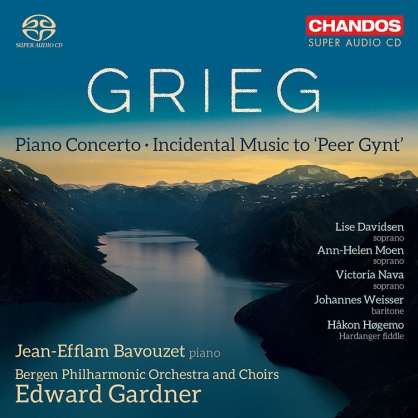
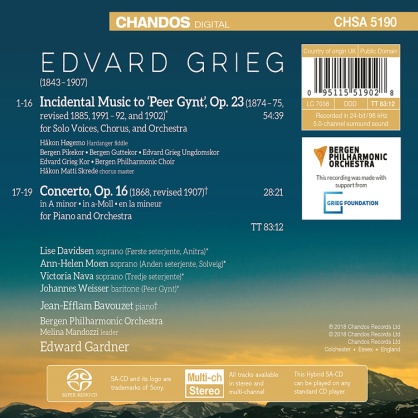
One of the more difficult reviews for me to write is this one because anyone who has even a modest collection of material will have these two works in their collection. Some won’t have the vocal but many will. Why then would you buy this recording? The Bergen Philharmonic know this as well as the Marine band playing The Star Spangled Banner. The Chandos recording is in the SA-CD mode so if you have the system the sound is unbelievable. Chandos for the most part makes superior recordings. If for some reason you don’t have these two wonderful melodic recordings they will be a welcome addition to your collection.
Edvard Grieg (1843-1907) was the Gershwin of Norway. Even today he is wildly popular for his material. Peer Gynt sound clips are heard in many films. As most of you know it is a very pleasant piece to listen to and the Bergen Philharmonic is top drawer.
There are many boxed sets of piano concertos and this one is often included. It stands on the same ground as the Tchaikovsky, Beethoven, and Rachmaninoff concertos. It is romantic and filled with wonderful melodies. A real winner.
If you don’t have these recordings get them. This is a good recording.
Metropolis
February 15, 2018
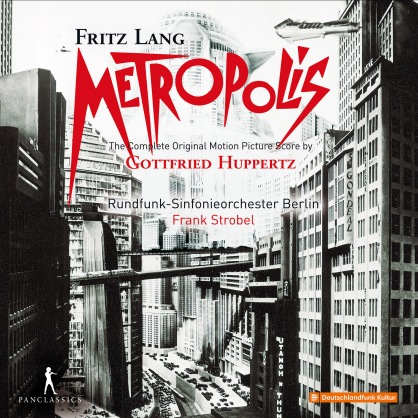
A noted critic commented ‘after a single acquaintance with this fantastic film and its music, it is naturally only possible to receive a general impression. Most striking was the cohesion of the two mediums with Huppertz’ music providing a significant orientation in the complex film.’
One can make the argument that this was the finest score ever written for a silent film in the 20’s especially Huppertz who only did 8 films out of his 40 compositions, the others being concert pieces for orchestra. I further argue that this ranks as an equal with my favorite score which is Nosferatu written by James Bernard, composer of many Hammer horror films.
Did Max Steiner, Franz Waxman, and Erich Korngold go to school and learn from this score; a resounding yes! In fact all six components detailed in Fabich’s book were used in their scores. It consisted of “leitmotifs, scene-related themes and motifs intended for a single passage within the film, longer sections primarily adhering to musical rules, ostinato figures with leitmotif character, musical description and quotations.” For those who are not familiar a leitmotif is a theme or phrase that denotes an actor, idea, or thought. The best example I can give is the “Jaws” theme to denote the shark danger. The ostinato phrase is one repeated over and over, probably a leitmotif. A good example in this score is the use of the Dies Irae death theme used a lot.
The reason for the greatness of this score was the hands on approach that Huppertz took. Instead of waiting to do the score upon completion Huppertz studied and researched the film on a daily basis. This aided in the synchronization process which made this score so superior to so many of its contemporaries. I can’t encourage you enough to watch the film and see how the music is an integral part of the movie and would be quite ordinary without it. https://www.amazon.com/Complete-Metropolis-Silent-Brigitte-Helm/dp/B004R0LJ5E
The music doesn’t sound like a typical silent film but more modern sounding. I’ve listened to it three times all the way through and the time goes by a lot quicker than one might think. The themes roll out one after another and after the third time you’ll find yourself humming the different melodies as the score is quite tonal in nature with very little in the way of atonal passages.
I’ve given you the prime amazon link to view the film. It has been cleaned up and is an easy watch for you. If you own any of the older CD’s get this new one and enjoy the complete unedited version of this classic score. Highly recommended.
Sergey Rachmaninov The Bells & Symphonic Dances
February 9, 2018
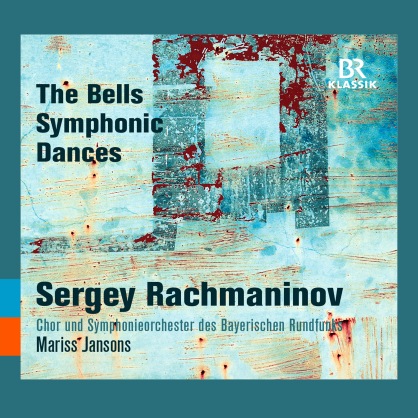
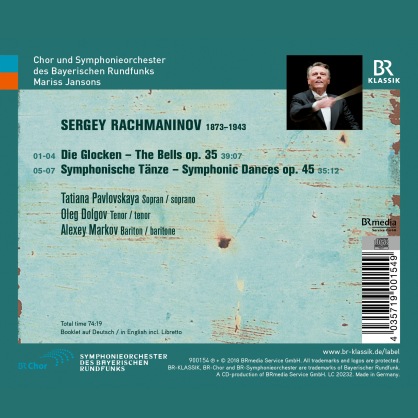
BRK 900154
“The Bells” (Die Glocken) was written in 1913 and is based on the Edgar Allen Poe poem. To put this in perspective Sergey was to do only 10 compositions until his death in 1943, a period of 30 years. The poem was sent to Sergey anonymously along with a letter urging him to write a work about it. It was translated by Konstantin Balmont (1867-1943) and it was different in many ways from the original Poe poem. Divided into four parts the work tells the story through the bells, orchestra, and voice. The first movement with sleigh bells suggests youth and care free times. The chorus is singing a lullaby and it is a dreamy sequence. All is happy and well in Russia. The beginning of the work reminds me of Bernard Herrmann. Only a few bars but a noteworthy observation.
In the second movement Balmont’s verses switch to the golden bells ringing, solemn, serious, and significant. A wedding? A solo soprano reveals a sensual bliss for the blessed occasion.
In the third movement we now hear the fierce real world of day to day life. The movement is quite disturbing offering little hope.
The final movement talks about death. The swinging bell is the coffin’s peace.There are many references to the end in this movement. The bell has spoken.
Rachmaninov’s final work, “Symphonic Dances” (1940), is a return to his ballet “The Scythians” (1915) where he dealt with ancient horsemen.
The first movement begins with staccato type phrasing complete with drums which represent the riders. The mood quickly shifts and we hear a theme from a mourning alto saxophone which is peaceful.
Tempo di Valse is the order of the day for the second movement and we hear a somewhat typical Russian Waltz with flute, the blaring of trumpets, and clarinet.
Rachmaninov knew that this final third movement was to be his last and he gave indications with “Dies Irae” and “Blessed be the Lord. “This was subtly written to be his swansong in nature although it begins as a piece that Ravel could have written (Rhapsody Espangol).
Overall this is one of my favorite orchestral works that I have several of in my collection. The advantage of this recording is the coupling with “The Bells” 74 minutes of material by a seasoned conductor on nicely recorded CD. If you don’t have these works they will be a welcome addition to your collection.
Lee Holdridge Collection Volume 1
February 9, 2018
| NEW FROM DRAGON’S DOMAIN |
 |
| THE LEE HOLDRIDGE COLLECTION VOLUME ONE Music From the Original Scores THE PILOT’S WIFE THE TENTH MAN Ships the week of February 5th $17.95
|
Review will follow soon. As you know I like Lee a lot. Look forward to a new Chris Young too.